Table of Contents
- Introduction
- Editor’s Choice
- Bitcoin Market Capitalization Statistics
- Statistics of Price Performance of Bitcoin
- Bitcoin Trading Volume Statistics
- Bitcoin Network Hashrate Statistics
- Demographics of Bitcoin Users Statistics
- Bitcoin Regional Statistics
- Biggest Public Companies with Bitcoin
- Bitcoin Mining Statistics
- Recent Developments
- Conclusion
- FAQs
Introduction
Bitcoin Statistics: Bitcoin, often called “digital gold” or a “cryptocurrency,” emerged in 2009, created by an enigmatic individual known as Satoshi Nakamoto.
It functions on a decentralized blockchain network, notable for its capped supply of 21 million coins, establishing it as a deflationary asset.
Bitcoin enables direct peer-to-peer transactions without intermediaries, employing robust cryptographic security measures.
It has garnered recognition as a digital store of value and a medium of exchange, attracting investments and offering potential solutions for remittances and financial inclusivity.
Despite encountering obstacles like regulatory scrutiny and scalability concerns, Bitcoin’s continual development is disrupting conventional financial systems, and its enduring influence on the worldwide economy remains a topic of profound interest and pioneering advancements.
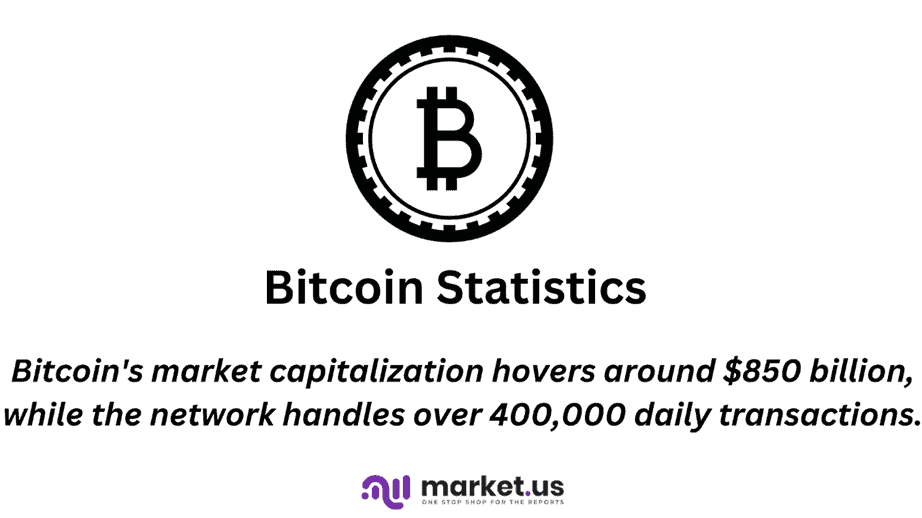
Editor’s Choice
- Bitcoin market capitalization hovers around $850 billion, while the network handles over 400,000 daily transactions.
- Approximately 100 million individuals worldwide are Bitcoin holders, and the number of distinct Bitcoin addresses exceeds 900 million.
- However, more than 65% of these addresses hold less than 0.001 BTC. The cryptocurrency landscape is vast, encompassing over 6,000 unique digital currencies.
- Digital Currency Market size is expected to be worth around USD 76.9 Billion by 2032
- Bitcoin enjoys frequent mentions on social media platforms, averaging one reference every 3 seconds.
- Projections suggest that the global blockchain market will grow to $23.3 billion by 2023.
- Approximately 46,000 nodes across the globe uphold the Bitcoin network.
- In terms of energy consumption, Bitcoin utilizes approximately 112 terawatt-hours per year, which aligns with Argentina’s energy usage.
- The Winklevoss twins are estimated to possess 1% of the total Bitcoin supply.
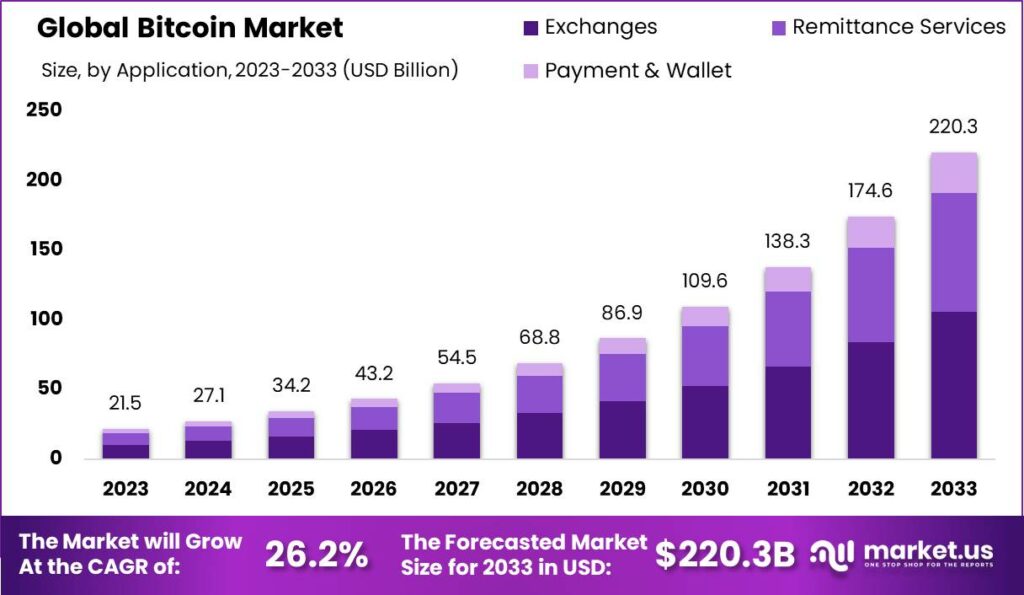
Bitcoin Market Capitalization Statistics
Current Market Cap of Bitcoin Statistics
- As of October 26, 2023, Its market capitalization is currently valued at USD 665.96 billion, and the 24-hour trading volume amounts to USD 19.27 billion.
- The price of BTC in USD is continuously updated in real time.
- It has a circulating supply of 19.52 million units.
(Source: Binance)
Historical Trends in Market Cap
- The market capitalization of Bitcoin (BTC) has exhibited remarkable growth and fluctuations over time.
- In April 2016, it stood at a relatively modest USD 6.94 billion, but by July 2017, it had surged to USD 47.39 billion, signifying its increasing popularity.
- By January 2018, Bitcoin’s market cap reached an impressive USD 172.1 billion, only to experience a decline to USD 109.63 billion by October 2018.
- The cryptocurrency’s value continued oscillating, reaching USD 149.01 billion in September 2019 and USD 117.81 billion in March 2020.
- The end of 2020 saw a significant upswing, with Bitcoin’s market cap soaring to USD 539.05 billion in December.
- The year 2021 was particularly noteworthy, with April marking a milestone as it crossed the trillion-dollar threshold at USD 1079.67 billion and reached USD 1156.49 billion by October.
- However, the market cap dipped to USD 865.2 billion in March 2022, illustrating its volatility.
- As of February 2023, it stands at USD 446.85 billion, with fluctuations expected to continue as Bitcoin remains a dynamic and influential cryptocurrency mining player.
(Source: Statista)
Take advantage of our unbeatable offer - buy now!


Statistics of Price Performance of Bitcoin
Current Price of Bitcoin
- The current price of Bitcoin stands at $34,108.07 per BTC when traded against the US dollar (BTC/USD).
- Over the past few months, Bitcoin has experienced a decrease of 1.85% in its value.
(Source: Binance)
Historical Price Chart And Trends
- The price of Bitcoin (BTC) has seen significant fluctuations over the years.
- In April 2016, it was valued at USD 451.82 per BTC, showing the relatively modest beginnings of this cryptocurrency.
- However, by July 2017, its price had skyrocketed to USD 2871.3, marking a substantial increase in its value.
- The momentum continued into January 2018, when Bitcoin reached an all-time high of USD 11157.6.
- Yet, by October 2018, it had experienced a significant correction, dropping to USD 5529.6. The price fluctuated further in March 2019, standing at USD 4028.3.
- In September 2019, Bitcoin was priced at USD 9997.2.
- In March 2020, it was at USD 5859.6.
- The end of 2020 saw a remarkable surge, with Bitcoin reaching USD 27125.3 in December.
- By April 2021, it had exceeded USD 48981.4, reflecting the increasing interest in cryptocurrencies. October 2021 saw another milestone at USD 62283.2.
- However, by March 2022, it had decreased to USD 44510.8.
- Further, October 2022 witnessed a notable drop to USD 20800.7.
- As of January 2023, Bitcoin is priced at USD 16950.8, highlighting the cryptocurrency market’s price volatility.
(Source: Global Data)
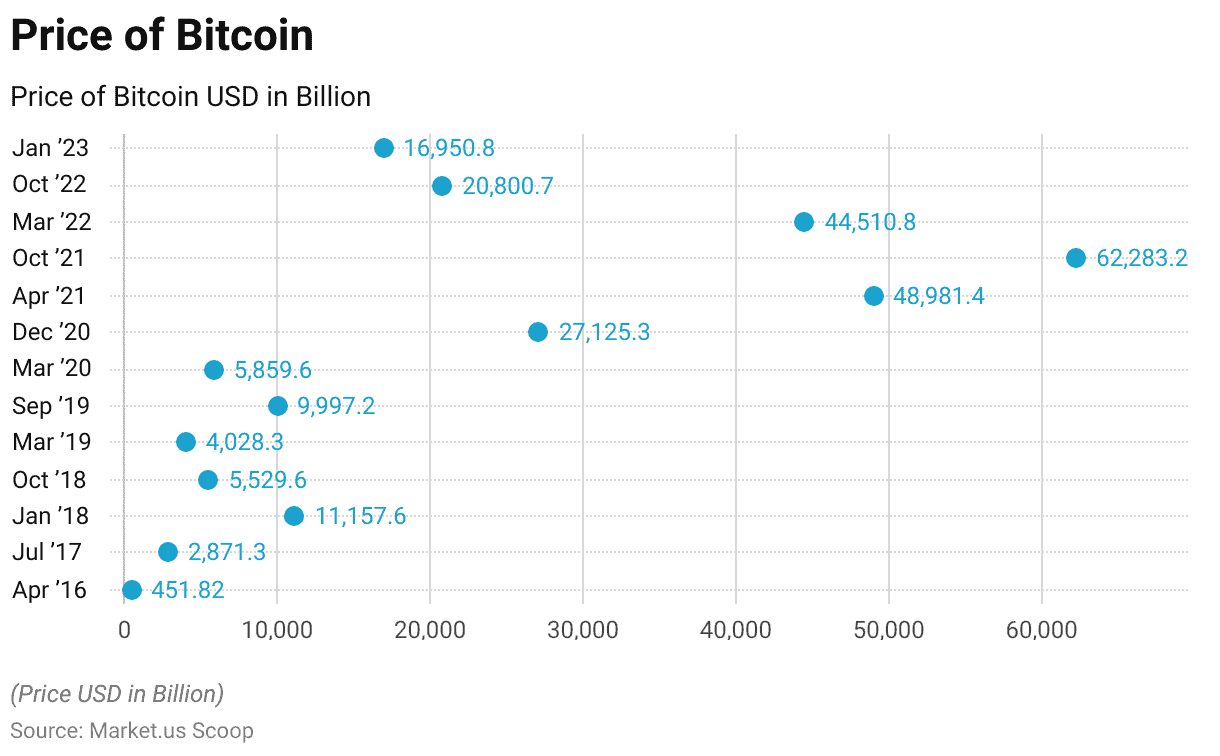
Bitcoin Trading Volume Statistics
Daily Trading Volume of Bitcoin Statistics
- The daily trading volume of Bitcoin (BTC) has witnessed significant fluctuations over time.
- On March 27, 2017, it stood at a relatively modest USD 0.3 billion, reflecting the earlier stages of the cryptocurrency market.
- By January 29, 2018, there was a substantial increase, with the trading volume reaching USD 8.6 billion, indicating growing interest and liquidity.
- In August 2018, it was at USD 4.2 billion, maintaining a relatively robust level of trading activity.
- January 28, 2019, saw a further increase to USD 5.6 billion.
- The trading volume surged to USD 14.9 billion on August 26, 2019, demonstrating heightened market participation.
- April 27, 2020, marked a notable milestone, with the daily trading volume reaching USD 45.2 billion.
- October 26, 2020, recorded a trading volume of $31.2 billion, reflecting continued market activity.
- January 25, 2021, saw a significant spike to $71.7 billion, showcasing the cryptocurrency’s increased prominence.
- However, by July 26, 2021, it had decreased to USD 33.4 billion. January 31, 2022, recorded a trading volume of USD 20.7 billion, followed by a slight increase to USD 29.8 billion on August 29, 2022.
- As of January 30, 2023, the daily trading volume stands at USD 24.7 billion, highlighting the dynamic nature of the cryptocurrency market.
- Looking ahead, October 23, 2023, recorded a trading volume of USD 32.5 billion, indicating continued interest and activity in Bitcoin trading.
(Source: Bitcoin Visuals)
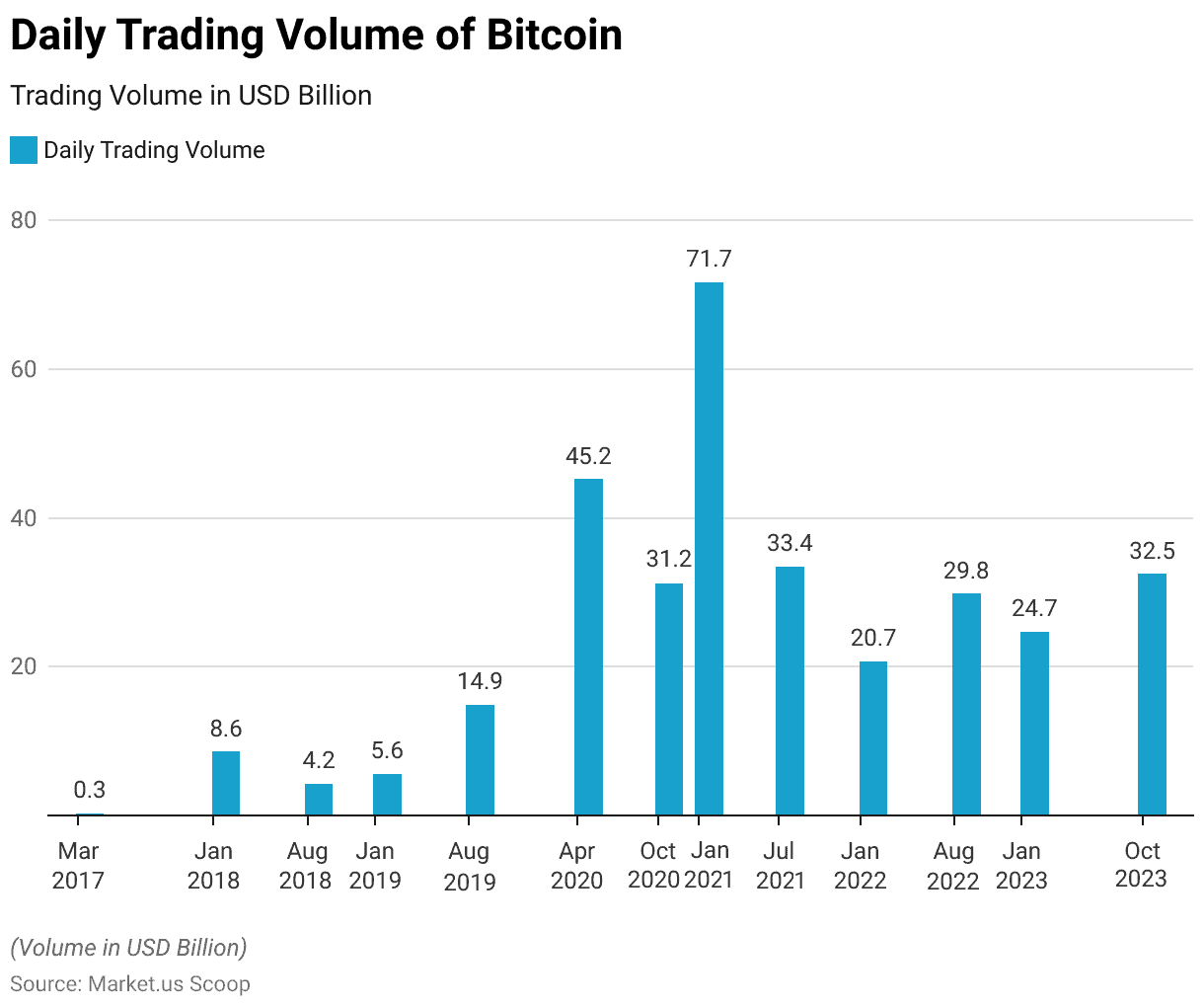
Bitcoin Transactions per Day
- The metric of Bitcoin transactions per day serves as an indicator of the network’s transaction volume.
- The Bitcoin blockchain functions as a transparent ledger, documenting all transactions within blocks generated approximately every 10 minutes.
- This metric is anticipated to increase as cryptocurrency gains broader adoption, resulting in elevated transaction levels and increased user participation.
- Bitcoin processes around 400,000 transactions per day, showing its scalability.
(Source: Statista)
Exchange-Wise Volume Distribution
- The distribution of Bitcoin trading volume across various exchanges reveals interesting insights into the cryptocurrency market.
- Among these exchanges, Coinbase stands out as a dominant player, accounting for 65.56% of the total volume, with a trading volume of 439 thousand.
- Following closely behind is Kraken, with 13.60% of the market share and a trading volume of 91 thousand.
- Bitstamp and Bitfinex also contribute significantly, with 9.63% and 7.57% market shares, respectively, and trading volumes of 64.4 thousand and 50.7 thousand.
- The Gemini exchange holds a 2.17% market share with a trading volume of 14.5 thousand.
- In contrast, smaller exchanges like Exmo, BTCMarkets, Korbit, and Bitcoin.co.id have market shares ranging from 0.14% to 0.79%, indicating a more limited presence in the market.
- Lastly, other exchanges comprise 0.05% of the market share, totaling 341 thousand in trading volume.
- This data highlights the concentration of Bitcoin trading activity on a few major exchanges while showcasing the diverse landscape of cryptocurrency trading platforms.
(Source: data.bitcoinity.org)
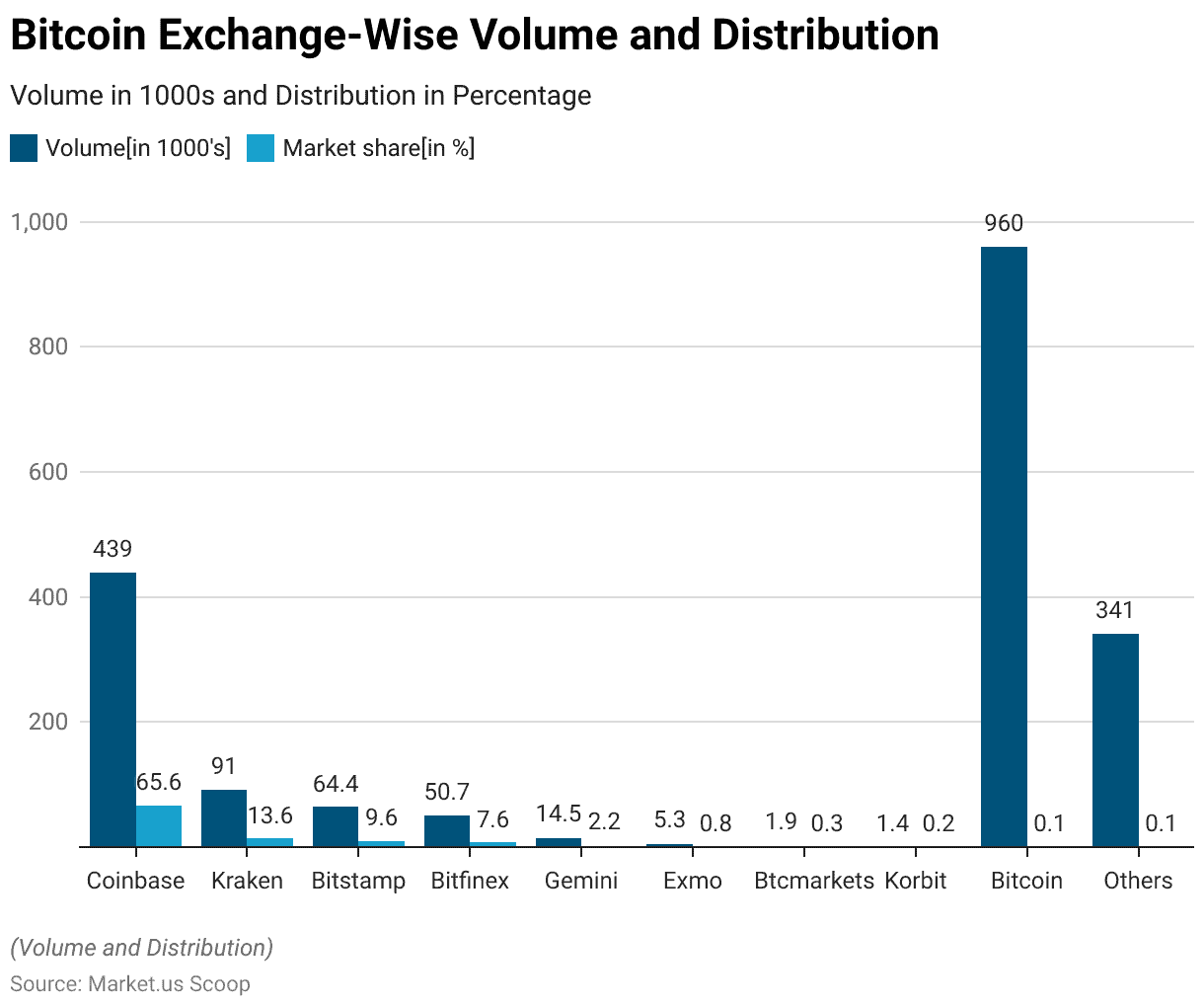
Bitcoin Network Hashrate Statistics
Recent Trends In Bitcoin’s Hashrate
- The Bitcoin hash rate reflects the network’s computational power and has displayed notable fluctuations over the specified period.
- As of October 3, 2022, the hash rate stood at 238.84 EH/s (exa hashes per second).
- Subsequently, by January 28, 2023, it had increased significantly to 298.0074 EH/s, indicating the network’s growing computational strength.
- This trend continued into April 1, 2023, rising to 318.23 EH/s.
- As of May 2, 2023, the hash rate surged to 362.87 EH/s, reflecting the ongoing expansion of the network’s computational capacity.
- However, by June 4, 2023, it experienced a slight decline to 339.96 EH/s, followed by a notable increase to 379.22 EH/s on July 11, 2023. August 21, 2023, recorded a hash rate of 419.33 EH/s, indicating robust network activity.
- By September 26, 2023, it stood at 392.33 EH/s, with fluctuations continuing.
- On October 26, 2023, the hash rate reached 486.49 EH/s, underlining the dynamic nature of Bitcoin’s computational power and the ongoing competition among miners to secure the network.
(Source: Coinwarz)

Demographics of Bitcoin Users Statistics
According to Age
- As per a survey, European Bitcoin users are distributed across various age groups, reflecting the diverse appeal of the cryptocurrency.
- The age group of 25-34 years comprises the largest segment, with 38.2% of Bitcoin users falling within this range.
- The 35-44 age group follows closely, representing 25.5% of users, indicating a significant presence in the mid-age bracket.
- Those aged 18-24 constitute 15.3% of Bitcoin users, while the 45-54 age group makes up 13.1%.
- Users aged 55-64 account for 5.6% of the total, and the 65+ age group forms a smaller yet notable portion, contributing 2.3% of Bitcoin users.
- About 55% of Americans aged 18-34 plan to buy Bitcoin by 2025, showing increased interest in younger generations.
- This demographic distribution underscores the widespread adoption of Bitcoin, spanning generations and indicating its relevance to a broad spectrum of individuals across age groups.
(Source: Bitcoin.com)

According to Gender
- 16% of men and 7% of women are involved with cryptocurrency.
- In the world of Bitcoin users, there exists a significant gender disparity, with males dominating the landscape, constituting a substantial 86.9% of the user base.
- Conversely, female representation in the Bitcoin community remains notably lower, accounting for 13.1% of the total user population.
- This gender imbalance in cryptocurrency underscores the need for greater inclusivity and outreach efforts to encourage broader participation and engagement among all genders.
- Efforts to bridge this gap and promote diversity within the cryptocurrency ecosystem continue to be a topic of discussion and action among the Bitcoin community and its stakeholders.
(Source: Bitcoin.com)
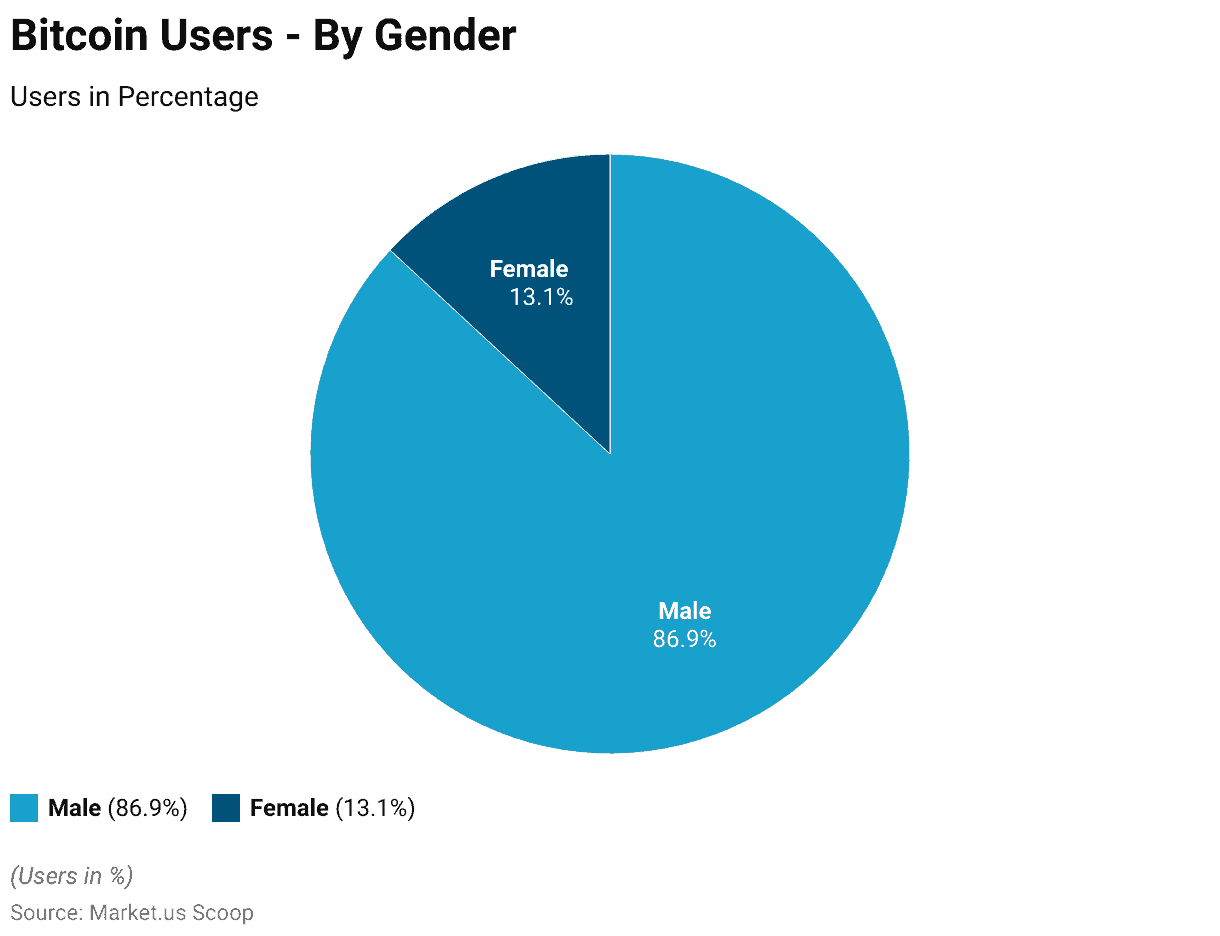
Bitcoin Regional Statistics
- Crypto and Bitcoin users are distributed across various regions, reflecting the global nature of digital currencies.
- Asia emerges as a dominant player in the cryptocurrency landscape, with a substantial 160 million users, highlighting its significant adoption and interest in the digital currency space.
- Europe follows with 38 million users, showing a notable presence in the continent.
- North America and Africa contribute considerably, with 28 million and 32 million users, respectively, while South America accounts for 24 million.
- However, Oceania on the other hand, registers a smaller user base, with 1 million users.
- This regional distribution underscores the widespread appeal and adoption of cryptocurrencies worldwide, with Asia leading the way in sheer user numbers.
(Source: Statista)
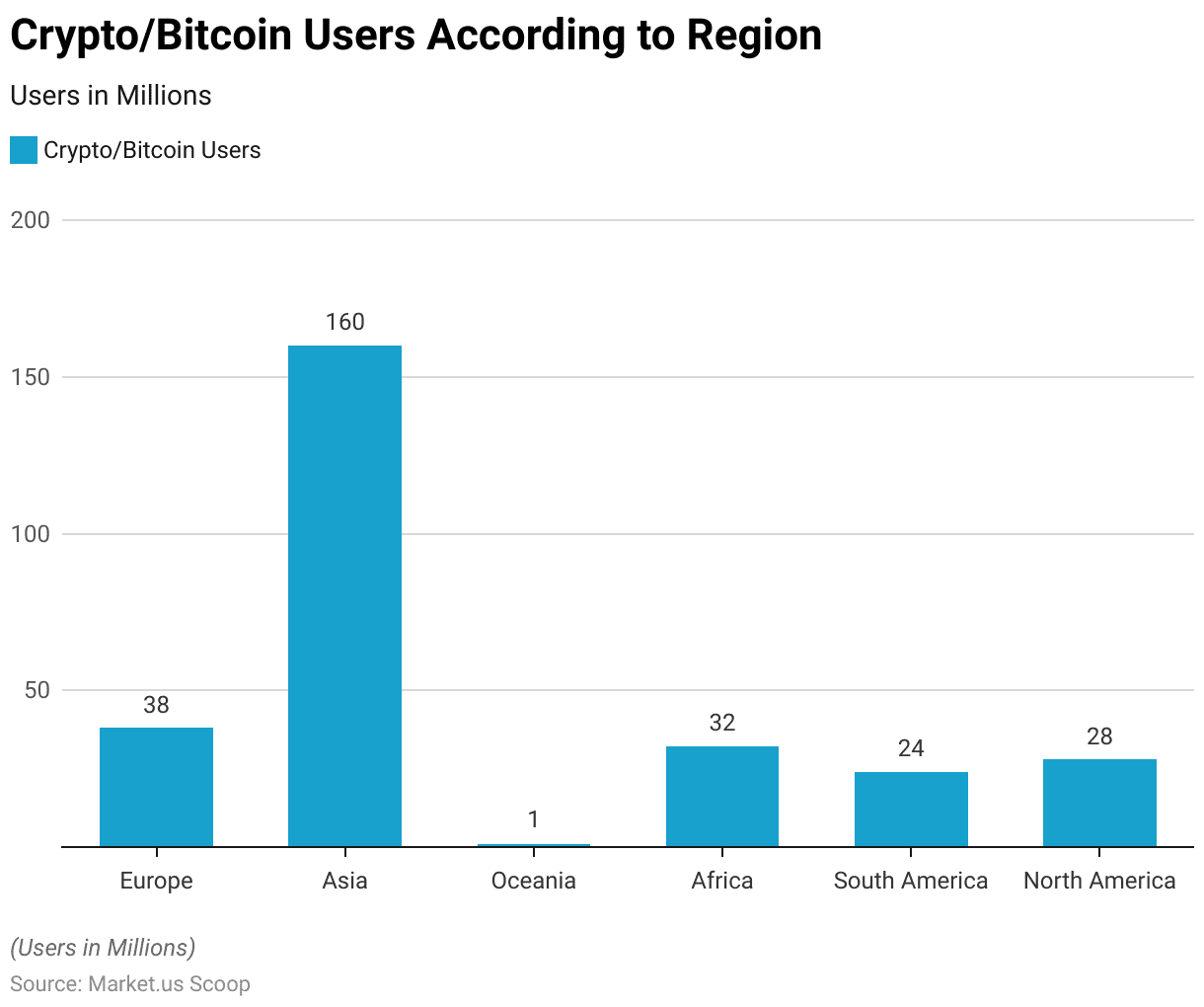
Top Countries With the Most Crypto/ Bitcoin Owners
- Cryptocurrency and Bitcoin users are dispersed across different countries, reflecting the global nature of digital currencies.
- India stands out as a prominent player in the cryptocurrency space, boasting a substantial user base of 100 million individuals.
- The United States, a significant hub for cryptocurrency innovation, follows with 30 million users.
- Russia and Nigeria also make notable contributions, with 18 million and 16 million users, respectively.
- Brazil is another country showing a strong interest in digital currencies, with 15 million users.
- Ukraine rounds out the list with 10 million users.
- This geographic distribution underscores the diverse and widespread adoption of cryptocurrencies, with various nations actively participating in the evolving digital financial landscape.
(Source: Statista)
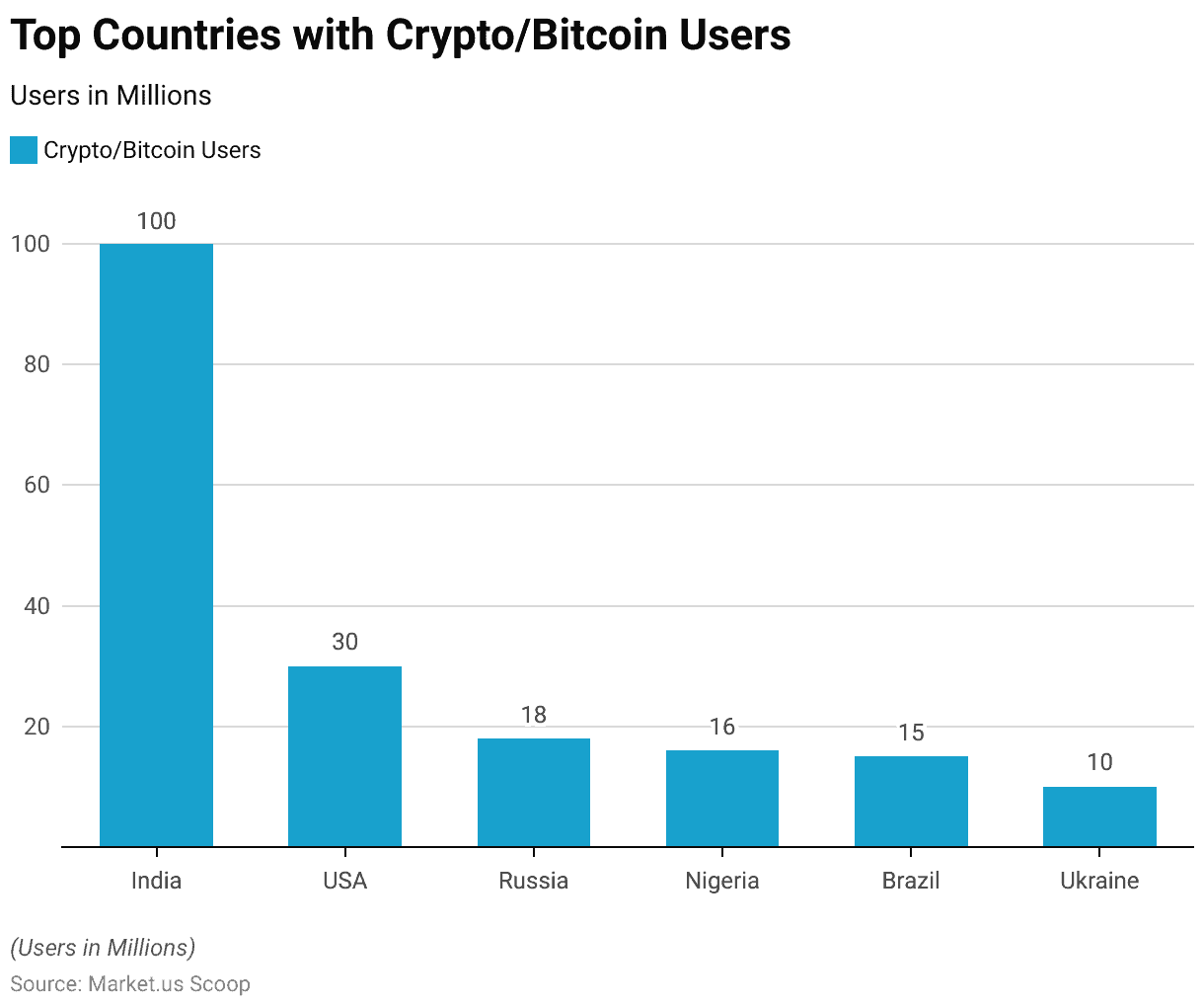
Biggest Public Companies with Bitcoin
- MicroStrategy holds over 129,000 BTC.
- Tesla and Coinbase made headlines for their Bitcoin investments.
- Marathon Digital aims to have over 199,000 Bitcoin miners by 2023.
(Source: Ycharts)
Bitcoin Mining Statistics
- Bitcoin mining consumes significant electricity, about 0.40% of the world’s total consumption.
- Bitcoin mining generates carbon emissions comparable to Sri Lanka’s.
- A single Bitcoin transaction’s carbon footprint equals over 497,000 Visa transactions.
- Bitcoin’s energy consumption is equivalent to Argentina’s electricity usage.
(Source: Zippia)
Recent Developments
Acquisitions and Mergers:
- Coinbase acquires Zabo: In mid-2023, Coinbase acquired Zabo, a cryptocurrency data aggregation platform, for $120 million. This acquisition aims to enhance Coinbase’s data services and provide better insights and tools for its users.
- Kraken acquires Staked: Kraken, a major cryptocurrency exchange, acquired Staked, a non-custodial staking platform, for $200 million in late 2023. This merger is expected to expand Kraken’s services in the growing market of cryptocurrency staking.
New Product Launches:
- Bakkt launches Bitcoin Rewards Card: In early 2024, Bakkt introduced a Bitcoin Rewards Card that allows users to earn Bitcoin as cashback on their everyday purchases. This product aims to increase Bitcoin adoption by integrating it into daily spending.
- Square introduces Bitcoin Payroll: Square launched Bitcoin Payroll in mid-2023, enabling employees to receive a portion of their salary in Bitcoin. This service is designed to simplify the process of earning and holding Bitcoin for workers.
Funding:
- BlockFi raises $500 million: In 2023, BlockFi, a cryptocurrency lending platform, secured $500 million in a Series E funding round to expand its services and enhance its further product offerings, including Bitcoin-backed loans and interest accounts.
- Chainalysis secures $300 million: Chainalysis, a blockchain analysis firm, raised $300 million in early 2024 to further develop its compliance and investigation tools for Bitcoin and other cryptocurrencies, aiming to ensure greater security and transparency.
Technological Advancements:
- Taproot Upgrade: Bitcoin’s Taproot upgrade, activated in late 2023, enhances privacy and security features by enabling more complex transactions and improving the efficiency of the network. This upgrade is expected to facilitate the development of more sophisticated smart contracts on the Bitcoin network.
- Lightning Network Growth: The Lightning Network, a layer-2 scaling solution for Bitcoin, continues to grow, with the number of nodes and channels increasing significantly in 2023. This development aims to enable faster and cheaper Bitcoin transactions.
Market Dynamics:
- Increased Institutional Investment: Institutional investment in Bitcoin has grown substantially, with companies like Tesla, MicroStrategy, and Square holding significant amounts of Bitcoin on their balance sheets. This trend is driven by the perception of Bitcoin as a hedge against inflation.
- Bitcoin ETF Approvals: Several Bitcoin ETFs (Exchange-Traded Funds) were approved in 2023, allowing investors to gain exposure to Bitcoin through traditional financial markets. These ETFs are expected to increase Bitcoin’s accessibility and drive further adoption.
Regulatory and Strategic Developments:
- US Executive Order on Cryptocurrencies: In early 2024, the US government issued an executive order aimed at ensuring the responsible development of digital assets, including Bitcoin. The order focuses on consumer protection, financial stability, and combating illicit finance.
- EU’s MiCA Regulation: The European Union introduced the Markets in Crypto-Assets (MiCA) regulation in 2023, providing a comprehensive framework for the regulation of cryptocurrencies, including Bitcoin. This regulation aims to enhance market integrity and protect investors.
Research and Development:
- Bitcoin Mining Efficiency: R&D efforts are focusing on improving the energy efficiency of Bitcoin mining, with initiatives exploring renewable energy sources and advanced hardware solutions to reduce the environmental impact of mining operations.
- Bitcoin as Legal Tender: Following El Salvador’s adoption of Bitcoin as legal tender in 2021, other countries are exploring similar moves. Research is being conducted to assess the economic impacts and feasibility of such policies.
Conclusion
Bitcoin Statistics – In conclusion, Bitcoin has emerged as a revolutionary force since its 2009 inception, challenging traditional finance and reshaping our understanding of currency and transactions.
Its decentralized, limited supply and secure nature have established it as both a digital store of value and a medium of exchange, attracting a diverse user base and institutional interest.
While its volatility and regulatory challenges persist, Bitcoin’s ongoing evolution, exemplified by technologies like the Lightning Network, aims to enhance scalability and transaction efficiency.
Its impact on the global economy remains an unfolding story, fostering innovation and debate. Bitcoin’s potential to empower individuals, provide financial inclusion, and redefine finance makes it a pivotal player in shaping the future of the financial landscape.
FAQs
Bitcoin is a decentralized digital currency created in 2009 by an anonymous entity or person using Satoshi Nakamoto’s pseudonym. It operates on a peer-to-peer network, allowing individuals to send and receive payments without intermediaries like banks.
Bitcoin operates on a blockchain, a public ledger that records all transactions. Transactions are validated and added to the blockchain by miners using cryptographic algorithms. These miners are rewarded with new Bitcoins for their efforts.
The blockchain is a distributed ledger that records all Bitcoin transactions. It consists of a chain of blocks, with each block containing a batch of transactions. The blockchain is decentralized and maintained by a network of nodes (computers) worldwide.
Bitcoin has a capped supply of 21 million coins. This scarcity is built into its code, and new Bitcoins are created as rewards for miners, but the issuance rate decreases over time through a process known as halving.
Bitcoin is known for its price volatility, and its value can fluctuate significantly. Additionally, it is subject to regulatory changes, security risks, and market sentiment.
The future of Bitcoin is a topic of debate. Some see it as a digital store of value, while others envision it as a global medium of exchange. Its role in the financial landscape continually evolves, and its future remains uncertain.
Discuss your needs with our analyst
Please share your requirements with more details so our analyst can check if they can solve your problem(s)



